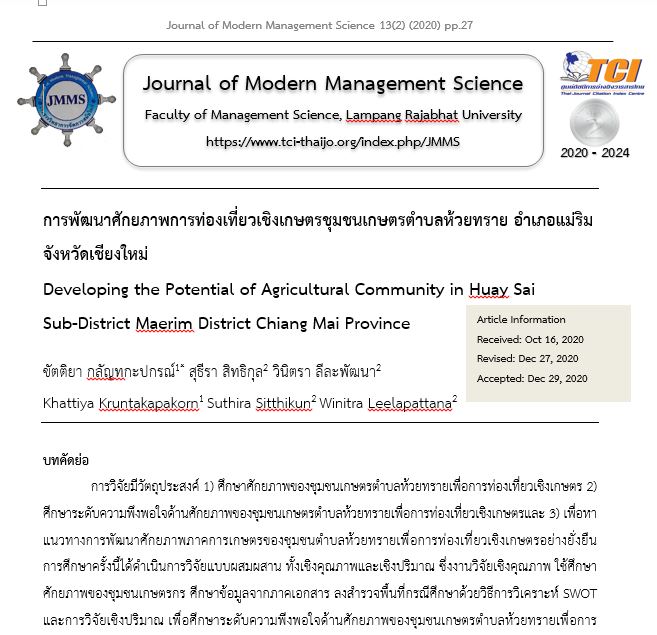Developing the Potential of Agricultural Community in Huay Sai Sub-District Maerim District Chiang Mai Province
Main Article Content
Abstract
This research aims to study on 1) the potential of the Huay Sai Sub-district agricultural community for agrotourism 2) to understand the satisfaction level of the potential of Huay Sai Sub-district agricultural community for agrotourism and 3) tourism find ways to develop the potential of the agricultural sector of the Huay Sai Sub-district community for sustainable agrotourism. This study was conducted in a combination of research both qualitative and quantitative research. The qualitative research used to study the potential of the farmers in the community. The documentary also for study all information needed. The SWOT analysis technique also used for understanding the area condition. The quantitative research used to study the satisfaction level of the potential in the Huay Sai Sub-district Agricultural Community for agrotourism. 120 undergraduate students from Chiang Mai Rajabhat University are the specific sample of this study by using questionnaires for data collection. The statistics used for data analysis were descriptive statistics, frequency, percentage, mean, and standard deviation. The study found that there are strengths and opportunities in the potential of the Huay Sai Sub-district Agricultural Community for agrotourism. In Huay Sai has good weather with the beauty of nature views, having privacy, quietness, the agro-tourism group has members with expertise in production, marketing, agencies and educational institutes to support management. There is a comprehensive management of the production process of agricultural products, to focus on organic farming without the use of chemicals in every production process. As for the weaknesses and obstacles, it was found that the route to travel is quite complicated. There are no clear signs or coordinates. In addition, the lack of participation of the people in the community, people lacking knowledge in event planning management, safety management in case of emergency as well as the lack of public relations in marketing, and also the weather affects the tourist season. The results of the study on the satisfaction level of the Huay Sai Agricultural Community for agrotourism were found that the overall picture was at the medium level by studying in the dimension. In addition, the dimension of the study found that the service potential of agrotourism sites was at the highest level, followed by the capacity of agrotourism attractions at the high level. The management potential of agrotourism sites was at a moderate level. The attractiveness of agrotourism attractions was at a low level and the market management potential of agrotourism sites was at the lowest level. The results of the study on the development of agricultural potential of the Huay Sai Sub-district community for sustainable agrotourism found that should start with marketing development first and then bring information to public relations activities or issues of unique community agrotourism sites. Then, organize activities to increase the capacity of tourism attractions and increase service potential by creating an impression of attractions and services, especially the important highlights of tourist attractions, food, service, rooms, etc., until customers feel impression and want to come back again.
Article Details
The article must be considered and accepted for publication by the editorial board of the Faculty of Management Science, Lampang Rajabhat University. The articles have been reviewed by a peer (peer review) and the author must update according to the suggestion if available before publication. Articles that are not considered the editorial team will inform the results of the consideration but will not send the original to the author.
JMMS is the Faculty of Management Science journal, Lampang Rajabhat University. Jmms published both print and online editions. We allow the use of articles for academic use under the scope of copyright law.
References
กาญจนา สุระ. (2556). การวิจัยเพื่อพัฒนาต้นแบบการพัฒนาเศรษฐกิจและสังคมของท้องถิ่นจังหวัดเชียงใหม่ ปีที่ 3. สำนักงานคณะกรรมการการวิจัยแห่งชาติ (วช.).
การท่องเที่ยวแห่งประเทศไทย. (2556). การศึกษาสถานการณ์และโอกาสการส่งเสริมตลาดการท่องเที่ยวกลุ่ม
นิเวศและผจญภัย. [ออนไลน์]. จาก http://etatjournal.com/web/menu-
download- zone/menu-dl-executive-summary/484-2555-dl-eco-adventure-ex-sum.
เกษราพร ทิราวงศ์ และอำนวยพร ใหญ่ยิ่ง. (2554). การศึกษาการพัฒนาศักยภาพชุมชนบ้านแม่แรม ตำบลเตาปูน อำเภอสอง จังหวัดแพร่ ด้วยการท่องเที่ยวเชิงนิเวศเพื่อสร้างความเข้มแข็งของชุมชนอย่างยั่งยืน. รายงานผลการวิจัยมหาวิทยาลัยแม่โจ้. เชียงใหม่: มหาวิทยาลัยแม่โจ้.
กรมส่งเสริมการเกษตร. (2548). วิสาหกิจชุมชน. กรุงเทพฯ: ผู้แต่ง.
กองเศรษฐกิจการท่องเที่ยวและกีฬา. (2560). รายงานภาวะเศรษฐกิจท่องเที่ยว. [ออนไลน์]. จาก https://www.mots.go.th/ewt_dl_link.php?nid=8404
จิตตินันท์ เดชะคุปต์. (2551). เจตคติและความพึงพอใจในการบริการ. เอกสารการสอนชุดวิชาจิตวิทยาการบริการ หน่วยที่ 8-15. (พิมพ์ครั้งที่ 12). นนทบุรี: มหาวิทยาลัยสุโขทัยธรรมาธิราช.
ดรุณ ไกรศรี. (2554). แนวคิดและทฤษฏีศักยภาพของบุคคล. จุลสารการท่องเที่ยว: กรุงเทพมหานคร.
บุญเลิศ จิตตั้งวัฒนา. (2542). การพัฒนาการท่องเที่ยวแบบยั่งยืน. เชียงใหม่: คณะมนุษยศาสตร์ มหาวิทยาลัยเชียงใหม่.
บุญเลิศ จิตตั้งวัฒนา. (2555). การจัดการด้านการตลาดอุตสาหกรรมการท่องเที่ยว. นนทบุรี: เฟริ์นข้าหลวง พริ้นติ้งแอนด์พับลิชชิ่ง.
ปัทมา สารสุข. (2558). แนวทางการพัฒนาการประชาสัมพันธ์การท่องเที่ยวเชิงเกษตร จังหวัดนครนายก. วารสารบัณฑิตศึกษา มหาวิทยาลัยราชภัฏสวนสุนันทา. 418-424.
ประชัย ศรีจามร. (2549). การมีส่วนร่วมของประชาชนต่อการปลูกป่าภาครัฐ กรณีศึกษาตำบลป่าอ้อ
ดอนชัย อำเภอเมือง จังหวัดเชียงราย. ภาคนิพนธ์ปริญญามหาบัณฑิต สถาบันบัณฑิตพัฒนบริหารศาสตร์
พจนา สวนศรี. (2546). คู่มือการจัดการท่องเที่ยวโดยชุมชน. กรุงเทพฯ: โครงการท่องเที่ยวเพื่อชีวิต
และคุณภาพ.
พิมพา หิรัญกิตติ และคณะ (2557). พฤติกรรมการท่องเที่ยวเชิงเกษตรของนักท่องเที่ยวชาวไทย. สุทธิปริทัศน์. 28(88) :362-384.
มงคล ด่านธานินทร์. (2541). เศรษฐกิจชุมชนเชิงระบบ: หลักการและแนวการปฏิบัติในเศรษฐกิจชุมชนพึ่งตนเอง: แนวความคิดและยุทธศาสตร์. กรุงเทพฯ: กระทรวงมหาดไทย กรมการปกครอง.
รัฐนันท์ พงศ์วิริทธิ์ธร และภาคภูมิ ภัควิภาส. (2559). แนวทางการพัฒนาการท่องเที่ยวเชิงเกษตรเศรษฐกิจสร้างสรรค์ของชุมชนบนพื้นที่สูง อำเภอแม่ริม จังหวัดเชียงใหม่. วารสารปัญญาภิวัฒน์. 8 (1).
-72.
รำไพพรรณ แก้วสุริยะ. (2544). เอกสารบทความ เรื่องทรัพยากรการท่องเที่ยว. กรุงเทพฯ: กองอนุรักษ์การท่องเที่ยวแห่งประเทศไทย.
วินิจ วีรยางกูร. (2532). การจัดการอุตสาหกรรมการท่องเที่ยว. กรุงเทพฯ: ภาควิชาบริหารธุรกิจ มหาวิทยาลัยเกษตรศาสตร์.
วิวัฒน์ชัย บุญยภักดิ์. (2536). สรุปปัญหาและการป้องกันแก้ไขผลกระทบของการท่องเที่ยวต่อ สิ่งแวดล้อม.
กรุงเทพมหานคร.
วีระศักดิ์ สมยานะ. (2558). แผนกลยุทธ์การเพิ่มขีดความสามารถในการจัดการทรัพยากรธรรมชาติของชุมชนจังหวัดเชียงใหม่ ภายใต้กรอกประชาคมอาเซียน ปีที่ 2. สำนักงานคณะกรรมการการการวิจัยแห่งชาติ.
สถาบันวิจัยวิทยาศาสตร์และเทคโนโลยีแห่งประเทศไทย. (2535). รายงานฉบับสมบูรณ์การศึกษาขีดความสามารถในการรองรับการพัฒนาการท่องเที่ยวของเกาะพีพี. กรุงเทพมหานคร: การท่องเที่ยวแห่งประเทศไทย.
สายใจ ทันการ (2558) การวิจัยและพัฒนาการประชาสัมพันธ์การท่องเที่ยวจังหวัดบุรีรัมย์ด้วยระบบสารสนเทศ ภูมิศาสตร์. โครงงานวิจัยนี้ได้รับการสนับสนุนจากสถาบันวิจัยและพัฒนา มหาวิทยาลัยราชภัฏบุรีรัมย์.
สำนักพัฒนาแหล่งท่องเที่ยวกรมการท่องเที่ยว. (2557). คู่มือการประเมินมาตรฐานคุณภาพแหล่งท่องเที่ยวเชิงเกษตร. กรุงเทพมหานคร.
สุเมธ ตันติเวชกุล. (2543). ใต้เบื้องพระยุคลบาท. พิมพ์ครั้งที่ 2. กรุงเทพฯ: มติชน.
องค์การบริหารการพัฒนาพื้นที่พิเศษเพื่อการท่องเที่ยวอย่างยั่งยืน. (2553). การท่องเที่ยวโดยชุมชน
(COMMUNITY - BASED TOURISM). [ออนไลน์]. จาก http://www.
DASTA.OR.TH/TH/%E0%B8%82%E0%B9%89%E0%B8%AD%E0%B8%9A%E0% B8%B1%E0%B8%87%E0%B8%84%E0%B8%B1%E0%B8%9A%E0%B8%
AD%E0%B8%9E%E0%B8%97/ITEM/674-674
World Tourism Organization. (1999). Tourism 2020 Vision: A New Forecast. Executive Summary Updated.


